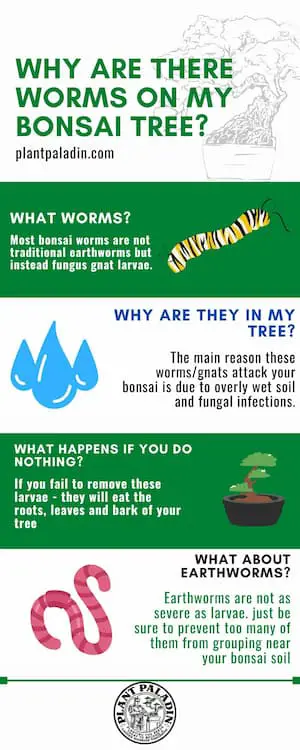This website is supported by its readers. If you click one of my links I may earn a commission. I am also a participant in the Amazon affiliates program and I will also earn a commission from qualified purchases.
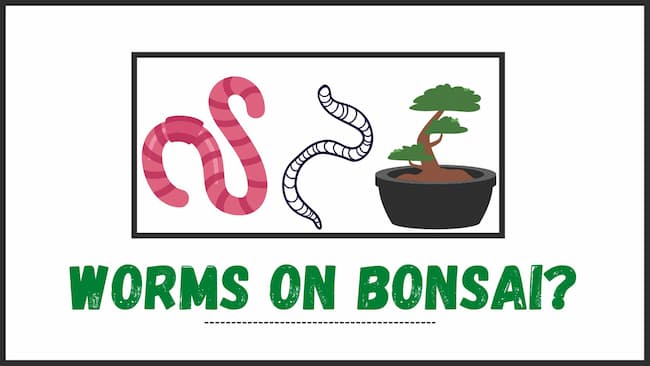
Due to the extreme wet weather, I’ve seen a lot of worms (and white worms at that) in the potting soil of my bonsai. With this being the first time I have come across this, naturally, a question I’ve had has been, why are there worms on my bonsai tree?
Worms on bonsai trees are commonly not worms but are instead grubs or lava of Fungus Gnat Flies, Beetles, Whiteflies, Aphids, Spider mites, and other insects. These “worms” will typically eat the roots, leaves, and bark of your bonsai as they grow and can cause significant damage.
During wet conditions, buried earthworms may also nest in deeper potted bonsai trees or bonsai planted in the ground.
So why exactly are there worms in your bonsai? And how can you remove worms from your bonsai? Keep reading to find out more!
Just a quick heads up, over the past three years of running Plantpaladin, hundreds of people have asked for product recommendations. As such, You can find my favorite indoor bonsai tree here (link takes you to Bonsaiboy), my favorite outdoor bonsai tree (link takes you to Bonsaiboy), or have a look at all the products I recommend here.
Why Are There Worms on My Bonsai?
If you take care of bonsai trees, you might have encountered worms on them and wondered, “Why are there worms on my bonsai tree?”
Well, the most typical causes are overwatering and using overly organic soil. But don’t worry. Depending on the type, there are both good and bad worms.
In this article, we’ll be discussing a few things about these worms and some preventive measures for them.
I quickly surveyed ten plant paladin readers, asking them why worms were in their bonsai trees. I’ve also contacted my local botanical gardens directly, asking them what they do in this scenario.
To summarize:
- Most worms in bonsai trees are not, in fact, worms but instead the larvae of fungus gnat flies.
- Other worms include larvae/grum forms of common insects such as aphids, beetles, whiteflies, and spider mites.
- If left unchecked, these worms will feed on the organic soil and eventually start to eat the roots of your bonsai tree – causing significant damage.
- Stop overwatering your bonsai tree to remove these worms and let the soil dry.
- You can use natural and chemical pesticides if you have a large infestation of these white worms.
- Earthworms may also be found in the potting soil of your bonsai tree, especially if you plant your bonsai in the ground outdoors ( such as due to the winterization process)
- Earthworms tend not to cause as much damage and may benefit your bonsai.
Overly Organic Soil
Contrary to some beliefs, most worms don’t eat your bonsai tree. Instead, they eat dirt, precisely the organic material in your soil.
Organic soil, like regular garden soil, is much heavier and holds water for a more extended period. As a result, worms ( or, more specifically, larvae) that prefer dampness will feed on the organic matter that builds up in the soil.
If worms/larvae are a long-term problem, consider investing in an inorganic soil mix.
Most bonsai can proliferate with inorganic mixes containing volcanic ash rock.
My recommendation would be:
50% Akadama, 25% volcanic lava rock, 25% pumice
You can read more here.
Now concerning what good potting soil contains, I would strongly suggest a mix that has good aeration, moisture retention and moisture flow.
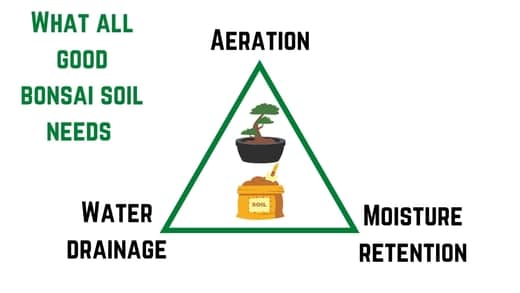
Overwatering
When organic soil is wet and then dries, it gradually hardens. Hardened soil will affect the growth of your bonsai, and it also makes watering difficult.
Sometimes, you might think you haven’t watered the bonsai enough when, in fact, all of the water goes to the bottom of the pot.
This harms your bonsai and can lead to root rot and fungal infections.
The effects won’t immediately show, but under that soil, the root of your bonsai tree is slowly decaying due to overwatering. And guess what? Worms also feed on that!
To prevent this, follow a routine watering schedule, only watering your bonsai when the topsoil is dry.
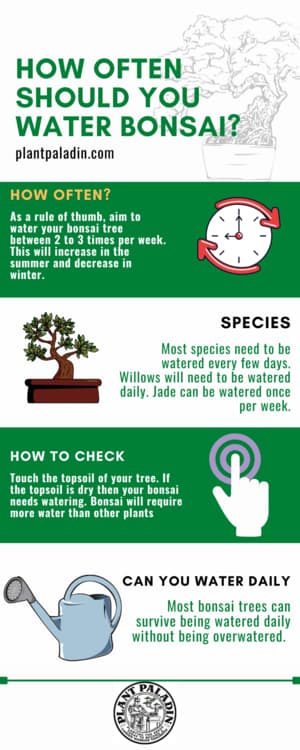
What Are These Worms?
These worms are most commonly fungus gnat larvae. They’re worms with small blackheads and thin white, almost see-through bodies. They also tend to stay within the soil and near the bottom of the pot.
But are these larvae good or detrimental to your bonsai tree?
Are These Worms Dangerous to Your Bonsai?
The answer is a big yes!
The fungus gnats’ larvae feed on the potting soil’s organic matter, such as algae, fungi, and decaying plant materials. Once their population gets out of hand, they will soon feed on your plant’s roots.
Extreme damage to your bonsai tree’s roots can lead to the death of the plant!
So, here are some signs of fungus gnat larvae infestations to look out for:
- Poor and slow growth
- Sudden wilting
- Bright yellow leaves
- Small, dark-colored flies hovering at the bottom of the potted plant
How to Remove Worms From Bonsai?
Getting rid of fungus gnat larvae from your bonsai should be quick and easy as long as you’re consistent. Just follow these few simple steps:
- First, stop overwatering your bonsai.
- Next, let the bonsai’s soil dry out more. This way, the fungus that gnat larvae feed on will be reduced, and so will the gnats.
However, fungus gnats do come in cycles. Hence, traps will be good to ensure their complete removal. Here are additional measures you can take:
- Put yellow sticky card traps on top of the soil.
- Put cider vinegar in a shallow container and place it near the base of the affected bonsai or, ideally, on top of the soil.
Remember to check and replace the traps for better effects regularly.
Can you use pesticides?
Pesticides can also remove these worms/larvae from your bonsai.
I’ve written an entire post talking about removal here, but a few methods you can follow include:
- Using parasitic wasps or ladybugs to eat the worms (a fantastic organic solution)
- Spray the worms directly with a mix of dish soap and water.
- Use neem oil in a cotton ball and apply it to the worms, killing them instantly.
- Use chemical pesticides to attack these larvae directly – ensure your bonsai tree is old enough to be able to handle any chemical pesticides. Any chemicals pesticides should contain the following chemicals to prove effective: Diazinon, Fenthion Malathion, Methyl-parathion, Sulfotep, and Trichlorfon.
What Are These Worms, and What Are They White?
Fungus gnats are considered minor pests of indoor houseplants. They’re small and delicate. These insects also have shiny heads and have a lifespan of 7–10 days.
Most importantly, they’re attracted to moist potting soil, where the adult female gnats will lay up to 200 eggs. These eggs will hatch after three days and will turn into larvae.
These larvae are the pale worms you will often see if you keep overwatering your bonsai tree and other potted plants. They’re naturally white, so they should have been easier to spot.
However, most fungus gnat larvae infestations take a long time to discover unless they have already done significant damage. That’s why it’s crucial that you prevent overwatering and always allow the soil to dry.
What Species of Bonsai Are More Susceptible to Worms?
There are many bonsai species, but none are more susceptible to worms than the others. In simpler words, worms will infest all bonsai trees if they aren’t correctly cared for.
Should your bonsai tree need to be watered more frequently or be used to overly wet soil, these trees will likely become the most infected by worms and larvae.
These bonsai species then include the likes of Willow, Oak, and fruit trees which all tend to be watered more frequently than common Ficus, Elm, or indoor species.
How to Prevent Worms From Attacking Your Bonsai?
There’s no absolute method that will prevent worms from attacking your bonsai. This is because different worms will require different precautions. However, the solutions indicated below will suffice as adequate measures:
- Don’t overwater your bonsai tree.
- Use inorganic soil as it helps in drainage and aeration. But if you want to use organic soil, choose an organic mixture with pine bark.
- So that you can take immediate action upon discovery, be on the lookout for pesky bugs and insects, like spider mites, fungus gnats, and aphids.
Are Earthworms Bad for Bonsai?
Earthworms can benefit bonsai trees by improving soil aeration and water infiltration. They also break down organic matter and make nutrients available to your bonsai.
However, too much can be dangerous since your bonsai tree could be overfed with too many nutrients. Overfeeding causes more problems and damage.
Are Earthworms Bad or Good for Bonsai?
Earthworms are helpful since they provide natural fertilizers advantageous to bonsai trees. However, the answer will vary depending on the worm in question.
Some worms benefit bonsai trees, and worms are more troublesome than good.
Survey results
Finally, I undertook a quick survey asking ten plant paladin readers why worms were on their bonsai, and what types of worms were on their bonsai.
Here are the results:
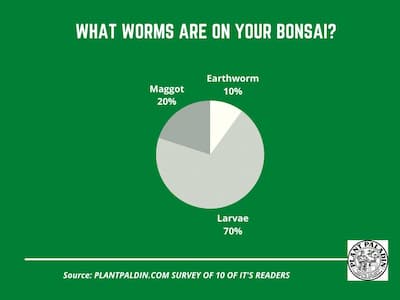
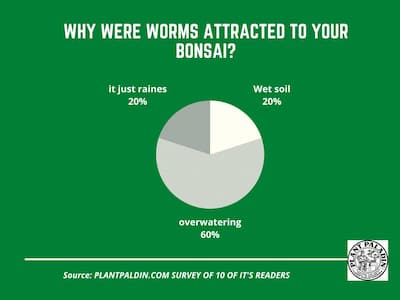
Conclusion
The bottom line is that all bonsai trees are vulnerable to worms. Whether the worms are good or bad for your bonsai will depend on what kind of worms they are. It’s also essential to ensure that the good worms don’t overpopulate.
Your bonsai tree will grow very healthy with excellent care! That’s as long as you plant it on good soil and don’t overwater. These two points have the most significant impact on plant growth!
My top picks for the gear you will need!
So like I mentioned earlier, over the past three years of running PlantPaladin, hundreds of people have asked me for my recommendations on the best bonsai gear on the market.
Having spent thousands of dollars on bonsai items these past few years and tested at least 100 bonsai-specific products, I’ve listed my favorite products below – All of which I highly recommend and think you can get great value.
They can purchase directly by clicking the link to take them to Amazon.
Bonsai Tool Set: One of the significant challenges I’ve had is finding a toolset that was not only durable but didn’t break the bank. SOLIGT has recently developed a fantastic bonsai tool set that covers all the tools you need to trim, prune, and repot your trees. – You can grab it here.
Complete Bonsai Set: Many of you will want to grow your bonsai trees entirely from scratch, but finding the varicose seeds, pots, and other items in one place can be challenging. Leaves and Sole then have created a complete bonsai set that I’ve personally used that ticks all the boxes. You can grab it here.
Bonsai wire: The number of times I’ve run out of wire for my bonsai or purchased cheap bonsai wire that doesn’t do the job is embarrassing for me to admit. After a lot of trial and error, I found that using Hotop’s aluminum bonsai wire is one of the best options on the market. This can easily be used for both indoor and outdoor bonsai. You can grab it here.
This post was written by Fehed Nicass who has been passionate about bonsai for over 3 years. He currently resides in the UK and works in sales.

